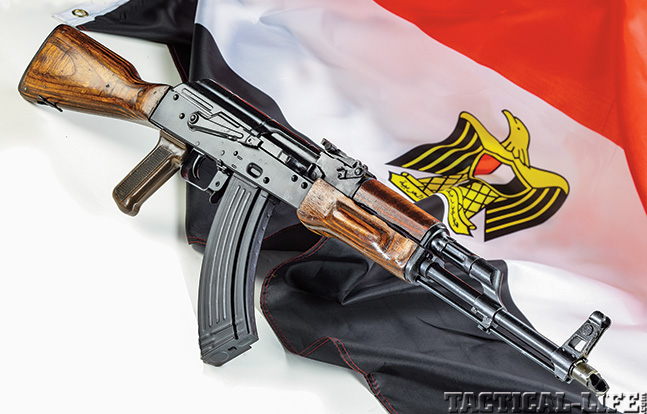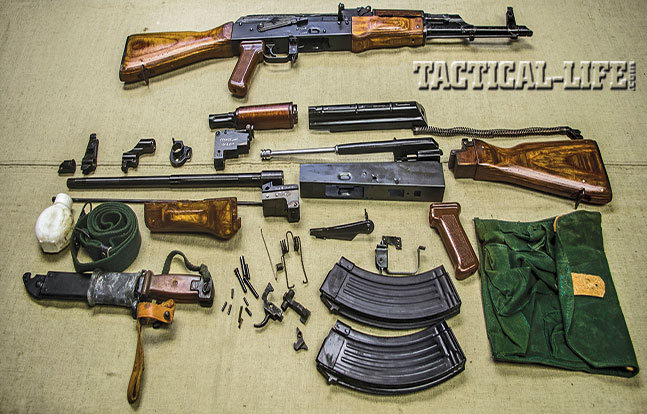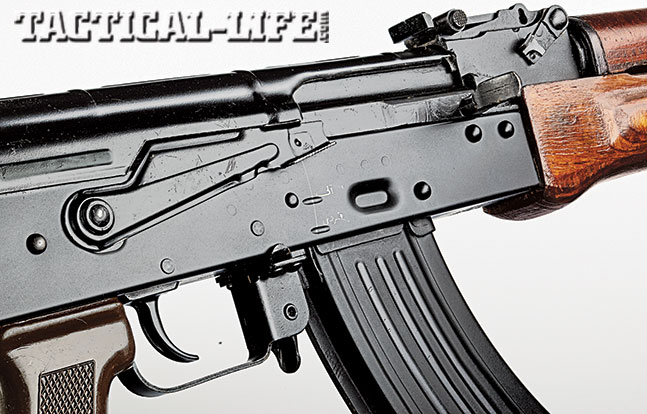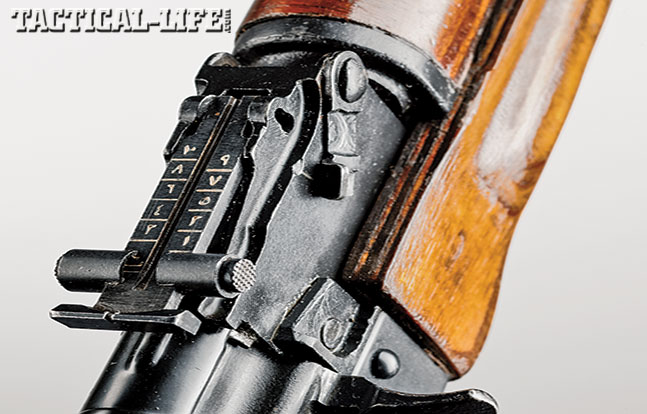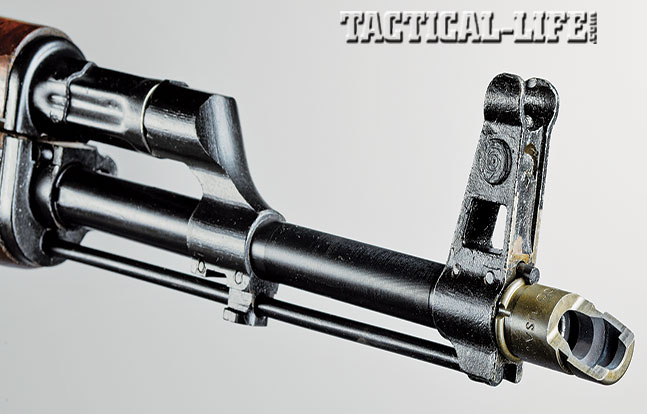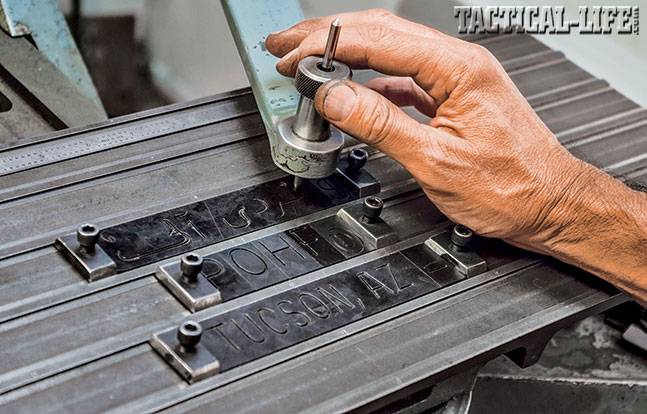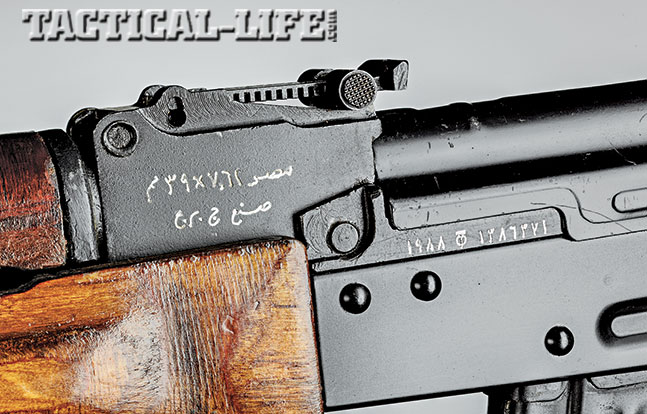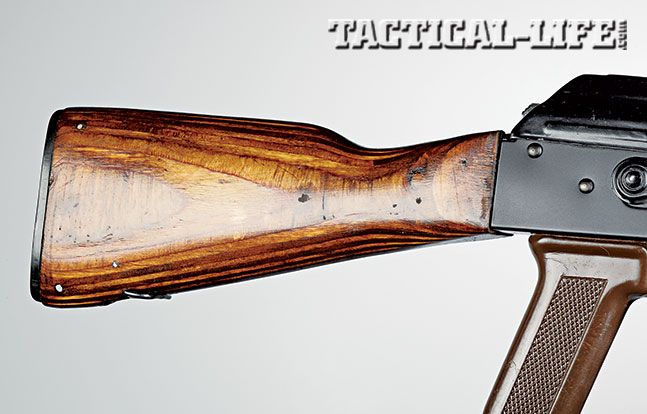“The name says it all,” explained Mario J. Fraire when discussing his company, Piece of History Firearms (POHF). “Before I got into the business, I would buy surplus guns for myself. So, I would research them, figure out what worked, did not work and what parts would be ‘correct’ for the particular firearm. My goal was to put them back to the way I thought they were supposed to be.”
This conversation came about as part of a project I was put-ting together on an Egyptian AKM build. I like to keep an eye out for interesting AK kits that turn up on the market as the basis for custom build projects, and I had lucked out and picked up a fixed-stock Egyptian “Maadi” AK parts kit from Arms of America. These were of particular interest to me as they were not only rated as being in “excellent” to “like new” condition with matching numbers, but also featured Arabic markings on the barrel trunnion, rear sight/mount block, top cover and sight leaf. With such a unique kit in hand, I realized that I needed a builder who would not only have the skill to properly build a functional semi-auto rifle from the kit, but also would want to make it as “correct” as possible from a historical standpoint.
After some research and asking around, I ended up contacting POHF to see if Fraire was available. During our phone conversation, I asked him about the nature of his business. “I have done stock guns for inventory in the past, but to be honest my time is just too limited with custom builds to do that. Early on, I would build guns and sell them at gun shows, but it got to the point where more and more people with their own kits were contacting me to work on their projects,” Fraire explained. “Now my business is roughly 95-percent commission work and 5-percent stock gun builds.”
Advertisement — Continue Reading Below
As the conversation continued, I told him that I had learned the tough lesson a while back about not buying a kit that I wanted when I saw it. “Some of my customers spend years assembling the parts for a build,” he said. “The more rare parts can be extremely hard to come by, so it is a smart move to buy something when it is available because it will be gone before you know it.” Fraire went on to explain that while many of his customers are like me and find the parts themselves, he also has customers that commission him to locate the parts and do the build—basically one-stop shopping.
As I was curious about the background of POHF, I asked Fraire how the company was started. I found out that Fraire is a trained woodworker and cabinetmaker and used to do construction work, but he would also work on builds as a hobby on the side. “I was unhappy with some of the work I saw from other gunsmiths. I thought ‘I can do better than this’ and started building guns myself,” he told me. Fraire would post pictures of his builds on
theakforum.net and would have people contact him and ask him to do work for them. Word of mouth built up demand, and he started getting more and more work offers. Fraire started POHF as a part-time operation around 2004. With construction work slowing down due to the economy and him realizing that he could devote his efforts to the business full-time, Fraire dedicated his time to POHF in 2009.
“I am not going to get rich doing this, but I enjoy it, and when I realized I could make a living at it I decided to make the move,” Fraire said. He soon built up a solid reputation for doing quality work. “All work I did for customers had to be good enough for me,” he told me. “I build it like I am building it for myself.”
Advertisement — Continue Reading Below
When I asked him how the market for AK builds has changed over the years, Fraire gave me a little background on what it was like for him when he started out. “Right when I was getting into building there was a big influx of affordable AK kits on the market. However, back then, there were very few options for U.S.-made parts. I worked with Ohio Ordnance receivers and Armory U.S.A. receivers, but they were only designed for fixed stock 7.62x39mm and 5.45x39mm AK rifles. So, I had to modify them for all the types of kits and variants I was building—underfolders, AKS-74s, etc. There was not a lot of info around back then on how to do these things, so I had to reverse engineer and basically just figure it out,” he told me.
By the end of the conversation, Fraire and I had worked out a schedule for the Egyptian AK build, and he asked me to get all the parts needed and send them on to him. We would discuss the project further once he had all that in hand. In addition to the Egyptian kit, I had also bought an original Romanian AKM barrel from Apex Gun Parts. Having commissioned builds before, I was aware of the 922r compliance parts requirements of a project like this. In addition to requiring a new U.S.-made, semi-automatic-only receiver, I also needed to acquire a U.S.-made fire control group and two other U.S.-made parts.
On Fraire’s suggestion, I put in an order for an NDS-1 stamped-steel receiver from NoDak Spud. These receivers are AKM-pattern units based on the 7.62x39mm Hungarian SA-85 and are fully heat-treated 4130 steel. They feature correct-style mag well dimples and correctly sized mag guides and magazine well openings. For the rest of the U.S.-made compliance parts, I ordered an Arsenal three-piece fire control group and a gas piston from K-VAR, along with a TAPCO “slant” muzzle device.
Advertisement — Continue Reading Below
Once I had all this in hand, I shipped it out to POHF and waited to hear back from Fraire. About a week later, I received a call from him. “This kit is really nice,” he said. “In fact, this is one of the better ones I have seen. The parts are in great condition and the markings are really nice.” In addition to the parts of the rifle, the kit also included an accessory pack with a sling, bayonet, mag pouch and oiler. Fraire let me know that he would get the build in the queue and be in touch with me in three to six months when it was finished and ready for shipping.
Gun Details
To fill the time while I was waiting for the build to be done, I decided to do some research on the origins of the Egyptian rifle and discovered an interesting history behind it. During the early years of the Cold War, Egypt underwent significant cultural and political changes. The overthrow of the Egyptian monarchy in 1952 signaled the nation’s move away from British influence, with the country espousing a new “anti-imperialist” creed. It soon moved into the sphere of influence of the Soviet Union, which was friendly to Egypt’s new outlook. One of the eventual results of this new relationship was the development of a domestically produced AKM-pattern rifle that would become known as the “Misr” (the Romanized Arabic name for Egypt). The rifle was unique in that it was a non-Warsaw Pact variant of the Soviet AKM. In fact, it was an extremely close rendition of the original Russian design, featuring very similar dimensions and configurations of parts. The rifles themselves were produced by the Maadi Company for Engineering Industries (Factory 54), part of Egypt’s Ministry of Military Production.
Advertisement — Continue Reading Below
As stated above, the Egyptian MISR closely followed the standard Russian AKM pattern. The stock set was in the AKM pattern, made from laminated wood and featured palm swells on the sides of the lower handguard. The rifle’s top cover was of thin sheet steel with reinforcing ribs for added strength, and the gas block was in the traditional 45-degree angle pattern. The finish of the rifles was a black paint applied over the metal parts. In fact, with just a quick glance at the rifle, it would be quite hard for many to easily distinguish it from a Russian-made rifle.
What really sets an Misr apart from a more traditional AKM are samples that feature Arabic markings. On these rifles, Arabic markings adorn the 1,000-meter marked rear sight leaf, the rear sight mount/block, the barrel trunnion and the selector markings. My initial inspection of the kit I purchased revealed that it was demilled from a rifle manufactured in 1988, and the condition of the parts and the finish were exactly as described.
After a somewhat impatient wait on my part, I received an email from Fraire letting me know the rifle was finished and being shipped to my FFL. Once it arrived, I hurriedly went out to pick it up. The rifle that I found there was, in my opinion, absolutely beautiful. I took the rifle home and put in a quick call to Fraire to go over the details of the build. He let me know that, due to the excellent condition of the parts kit, he left them with their original finish and only did a moly resin baked-on black finish over Parkerizing on the receiver.
Advertisement — Continue Reading Below
I asked him to give me a breakdown of the steps involved in one of his builds. He explained that after he logs in the parts, he inspects them for condition and completeness (and to evaluate if any of the smaller parts needed might be missing). Sometimes he finds that there are damaged parts in the kits, and he wants to be able to let the customer know as soon as possible about this. After this step, he verifies that he has all the 922r compliance parts needed and then moves on to cleaning and fully demilling the kit the rest of the way. After this step, he then does the cosmetic work on the receiver (selector markings, detents, sanding, etc.) and then rivets it all together. Fraire then installs the barrel, ensuring it is lined up and headspaced correctly and then drills it for pins. Finishing, final assembly and test firing are the final steps. Finishing options he offers (depending on the nature of the kits and the build) are Parkerizing, moly resin coating over Parkerizing and hot bluing.
I noted on the rifle build that Fraire had recreated the Arabic selector markings on the rifle and inquired about that process. “I go old-school with this,” he told me with a laugh. “I use a pantograph engraving machine to do this work. I engrave it manually, and this is not an easy process,” he said. Fraire explained that he intensively researches markings for the guns he builds and has copy plates made for the engraving. “I like to work with the pantograph as I can make as many passes as I need to get it right. Engraving sheet metal can be tough as it is not consistently flat. It can take five to 10 passes to get the cuts the same depth,” he explained.
Range Time
Advertisement — Continue Reading Below
Now that I had the rifle in hand, I wanted to get it out to the range to put it through its paces. I disassembled and inspected the rifle, giving it a light lube, and then reassembled it. I then headed out to the range with a selection of Century Red Army Standard, Ammo Importers Arsenal and Winchester 7.62x39mm ammunition. The Century ammunition was steel-cased, while the Arsenal and Winchester loads were brass cased.
I set up the target at 100 yards and started running the rifle for accuracy. Shooting batches of three 5-shot groups, I found that the rifle was capable of accuracy in the 2- to 3-inch range, with the tightest group being an impressive 1.65 inches with the Red Army Standard ammo (for which it showed a distinct preference). There were no malfunctions during this process. After I had finished up the accuracy testing, I then ran the gun for function. I ran numerous full magazines through the rifle, mixing the steel- and brass-cased ammunition in the magazines. I did not have a single malfunction. Several magazines from a variety of manufacturers fit perfectly into the magazine well and locked solidly into position. The trigger pull with the Arsenal fire control group was 4.5 pounds, with some grit to the pull that smoothed out a bit with use.
Final Notes
Advertisement — Continue Reading Below
Needless to say, I was very happy with the results of this custom build project. The rifle itself is quite attractive (at least to the eyes of a Kalashnikov enthusiast like me), and is a rock-solid performer. It is functional and surprisingly accurate. However, as with so many unique and interesting AK variants, the end result is much more than simply the sum of its parts for me. With the combination of a very unique parts kit and a builder that respects the history behind it, I came away with a great addition to my collection.
